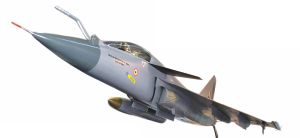Hindustan Aeronautics Limited (HAL) hopes to hammer out a Rs 39,000-crore deal with the Indian Air Force (IAF) by April 2020 for Light Combat Aircraft (LCA) Mk-1A jets. The IAF plans to buy 83 LCA Mk-1A jets, taking the total number of Tejas variants ordered to 123.
Price negotiations are over. The deal is expected to be signed by April. The deal was earlier expected to be worth around Rs 56,500 crore. The over Rs 17,000 crore reduction in overall cost came after hard-nosed negotiations spread over a year. The defence ministry and IAF were initially shocked at the “exorbitant price” being demanded by HAL to produce the 83 Tejas Mark-1A jets along with the maintenance and infrastructure package.
With the contract price now settled at Rs 39,000 crore, the procurement file is being sent to the Cabinet Committee on Security for final nod. It should be cleared before this fiscal ends on March 31. Once the contract is inked, HAL promises to begin deliveries of the Mark-1A jets in three years.
The MoD placed an order for 40 Tejas LCA Mk I with HAL, including eight tandem two-seat LCA trainer aircraft, divided into two batches of 20 aircraft each in 2006 and 2010 respectively. To date, the IAF has taken delivery of 17 Tejas LCA in initial operational configuration or capability (IOC), which means the fighter jet meets the minimum requirements for operational deployment by the IAF.
The Tejas LCAs are operated by No 45 Squadron (Flying Daggers) at Sulur in southern India. The squadron is expected to receive three more Mk I aircraft in the summer months of 2020. The remaining 20 Mk Is are scheduled for delivery by 2022 in final operational clearance (FOC) configuration. The Tejas Mark I LCA was awarded FOC status by the Indian Aeronautical Development Agency (ADA) in February 2019.
In February 2019, the LCA was given final operational clearance by Centre for Military Airworthiness and Certification (CEMILAC).
Crucial for HAL’s Order Books
Only two fighter production lines were open at HAL – one for Sukhoi-30s and the other for LCA Tejas. The Sukhoi-30 line is expected to shut after HAL delivers 12 fighter jets to IAF as part of an order likely to be signed later this year.The Tejas order was crucial for the HAL to prevent a complete halt of production at its facilities. HAL’s order books are empty beyond 2021-22 and new orders from the armed forces are critical for continuity in production. In a report tabled in Parliament in December 2019, the Parliamentary standing committee on defence said “all-out steps” should be taken to ensure that the “order book position” of defence public sector units such as HAL improved in the coming years and the ministry should extend full cooperation to achieve that.
Another order that HAL is eyeing is the supply of 70 locally produced basic trainers to the IAF. If it gets the order for the Hindustan Turbo Trainer-40 (HTT-40), HAL could begin production of the trainers by early 2021.
Improved Tejas
The LCA Mk-1A will come with additional improvements over the FOC aircraft, making it the most advanced Tejas variant so far. The IAF has listed several technical deficiencies found on the Tejas LCA Mark-I variant in 2017. These flaws will purportedly will be addressed in later variants of the aircraft, which will include 43 improvements over the existing version.
The Mk-1A variant is expected to come with air-to-air refuelling, digital radar warning receivers, external self-protection jammer pods, active electronically scanned array radar, advanced beyond-visual-range missiles and significantly improved maintainability.
HAL and Israel Aerospace Industries (IAI) subsidiary Elta Systems signed a contract for the purchase of 83 ELM-2052 active electronically scanned array (AESA) radars and ELL-8222WB electronic warfare (EW) suites to be integrated with the Mark-IA in October 2018.
The Mk IA variant, powered by a General Electric F404-GE-IN20 turbofan engine, will be around 1,000 kg lighter than the Mk I. The newer variant will purportedly also have less maintenance requirements.
The flight testing for Tejas Mark-1A will hopefully be completed by 2022. After these 123 fighters, the IAF is also looking to induct 170 Tejas Mark-2 or the MWF (medium weight fighter) jets with more powerful engines and advanced avionics.
But the Tejas Mark-2 and the indigenous stealth fifth-generation fighter aircraft called the advanced medium combat aircraft (AMCA) will take several years to fructify. For now, IAF is keeping its fingers crossed the Tejas Mark-1A does not get delayed any further.
Comments
It was in November 2016 that the Defence Acquisitions Council had first approved the procurement of 83 Tejas jets at a cost of Rs 49,797 crore. But HAL had responded with a quote of around Rs 56,500 crore, which led to protracted cost negotiations. HAL, for instance, was even charging profit on imported components. Item by item, the cost was brought down. IAF also cut down some of its support requirements.
Down to just 30 fighter squadrons (each has 18 jets) when at least 42 are required for the requisite deterrence against Pakistan and China, the IAF is banking upon the long-delayed light combat aircraft Tejas to make up the free fall in numbers.
The first four Rafale fighters will touch down at Ambala airbase in May, with the remaining 32 following in batches by April 2022 under the Rs 59,000 crore deal inked with France in September 2016. But the slow production rate of the home-grown Tejas fighters by HAL, much like its protracted development saga, remains a major concern for IAF.


















